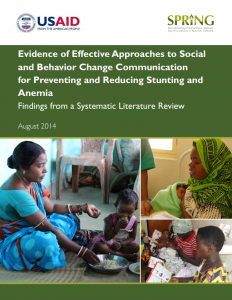
Breastfeeding is widely recognized as one of the most costeffective investments to improve child survival (UNICEF, 2013). According to The Lancet Series on Maternal and Child Under Nutrition, the adoption of exclusive breastfeeding through six months of age and continued breastfeeding through age two in 36 high burden countries could avert 11.6% of all deaths in children under the age of one, and nearly 10% of all deaths in children under the age of two (Bhutta et al., 2008a). The benefits of breastfeeding stretch beyond a child’s survival. Breastfed children do better on cognitive and motor development tests, and generally achieve better academic outcomes than non-breastfed children (Horta et al., 2013).
Additionally, breastfeeding imparts critical benefits to the woman. When practiced exclusively, breastfeeding is associated with lactational amenorrhea, the natural postnatal infertility that occurs when a woman is amenorrheic (not menstruating). The lactational amenorrhea method (LAM) is considered a modern method of contraception that prevents a second pregnancy within six months of giving birth, and helps to conserve maternal iron stores (Dewey et al., 2001). Increased birth spacing improves both the health of the woman and her infant’s chances of survival, while suboptimal pregnancy intervals are associated with an increased risk of adverse perinatal and infant/child outcomes including preterm birth, low birth weight, small for gestational age (SGA), stunting, and underweight infants/ children (Bhutta et al, 2013; Conde-Agudelo, 2006; Conde- Agudelo et al., 2012; Rutstein, 2008).
The World Health Organization (WHO) recommends three primary breastfeeding practices: initiation of breastfeeding within one hour after birth (also referred to as immediate breastfeeding), exclusive breastfeeding (EBF) through six months of age, and continued breastfeeding until 24 months of age (Dyson et al., 2005; WHO, 2008). Evidence associated with the recommendation for immediate breastfeeding is limited and likely operates through the effect of exclusive breastfeeding (Bhutta et al., 2013). The Lancet, therefore, includes only EBF and continued breastfeeding in the modeling of optimal breastfeeding practices cited above.
Despite the promise of optimal breastfeeding practices, rates for the three WHO recommended breastfeeding practices remain low, and negligible progress has been made to increase these rates over the past two decades (UNICEF, 2013). According to an analysis of data from 78 low and middle income countries, rates of immediate breastfeeding range from a mean of 36% in Eastern Europe to a mean of 58% in Latin America, and the rate of exclusive breastfeeding in children one to five months of age is just 30% (Black et al, 2013). According to the UNICEF global database of national surveys from 2007-2011, the current rate of breastfeeding at one year is 76%, while the rate of breastfeeding at age two years is 58%.
This chapter reviews the effectiveness of social and behavior change communication (SBCC) approaches on improving breastfeeding practices.